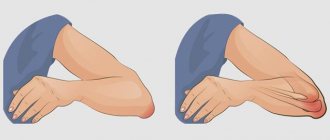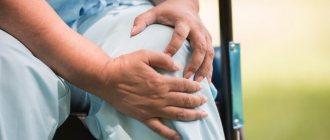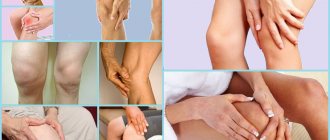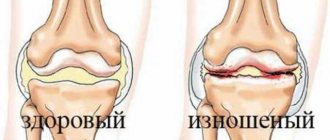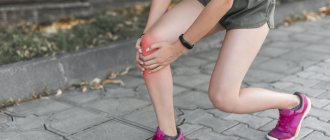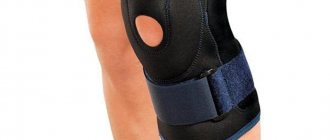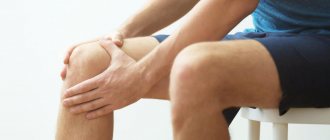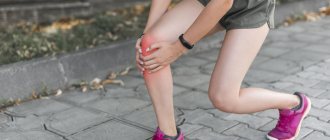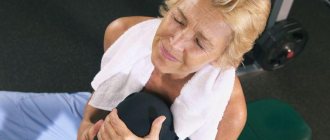The knee is a large joint with a large and constant load. It is not surprising that injuries often occur here and the risk of knee joint diseases is high. Periodic knee pain bothers almost 50% of people at the age of 40, and by the age of 70 it becomes a constant companion. One of the common pathologies of this joint is bursitis of the knee joint. In this case, the periarticular sac becomes inflamed and fluid accumulates in it. Movement becomes limited and painful. Doctors at the Kuntsevo Medical and Rehabilitation Center know how to recognize and treat bursitis. The clinic’s specialists are ready to help with acute and chronic forms of the disease using the most modern, safe and effective methods.
Knee bursitis and its types
The term “bursitis” is applied to the inflammatory process that occurs in the anatomical structure of the joint – the bursa.
This is a kind of hydraulic airbag - a cavity made of dense connective tissue that protects the joint from external damage. On the outside, it consists of dense tendons and ligaments that provide a durable outer covering. Inside is a layer of cells that produce synovial fluid. This is a special joint lubricant that facilitates the sliding of bone heads in it, protects tendons from friction, nourishes and moisturizes joint tissues. When moving, cartilage, like a sponge, absorbs this liquid along with nutrients.
The knee is a complex joint, in which there are several synovial bursae: above, below and in front of the kneecap, on the lateral ligaments, tendons, heads of the gastrocnemius and popliteus muscles. Inflammation can appear in each of them or in several at the same time.
Bursitis occurs at the site of inflammation:
- Anterior kneecap - prepatellar - inflammation and swelling occur as a result of diseases such as rheumatism, gout and from constant injury. For example, when working specifically with frequent support on the knee. Maid's or priest's bursitis is what they call this type of pathology, in which the front of the knee swells.
- Popliteal – the tendon bursa in the lower part of the kneecap becomes inflamed. A typical cause for this type of pathology is falls and strong impacts to the knee, injuries and tears of the meniscus. Traumatic bursitis of the knee joint is common in people with arthritis or excess weight.
- Goose - or Baker's cyst. Inflammation occurs in the inside or back of the joint. It manifests itself as pain in the knee when moving, walking up stairs, and more often affects overweight women.
Knee bursitis is classified according to its course:
- Acute – occurring suddenly, with noticeable and intense symptoms and lasting up to a month.
- Subacute.
- Chronic – lasts up to a year.
- Recurrent - periodically worsens.
According to the type of cause, bursitis occurs:
- Aseptic is a non-infectious pathology caused by injuries (post-traumatic bursitis of the knee joint), gout, and autoimmune diseases.
- Septic – caused by bacteria or infections (tuberculosis, syphilis and others).
According to the type of accumulated synovial fluid: serous, purulent and others.
An accurate classification of bursitis is needed to understand its cause and which treatment methods will be effective.
What is this?
This is an inflammation of the periarticular bursae (from the Latin bursa - bag). Near some joints there are small cavities called bags that allow tissue to glide over the bones. Strictly speaking, the bursae are not directly related to the joints, are not connected to them, but are simply located nearby. From the inside, they are lined with a synovial membrane, which normally secretes a small amount of fluid, which is enough to lubricate and slide the tissues. When such a bursa becomes inflamed, the joint itself is not involved in the process.
Symptoms
General signs of bursitis of the knee joint (they will appear when different joint capsules are affected) include:
- Pain – bothers you at rest or when moving: running or walking up the stairs. Pain with bursitis of the knee joint most often occurs in the morning and gradually increases with increasing strength or intensity of exercise.
- Swelling – of the knee as a whole or of a specific joint capsule.
- A rise in temperature – both local (a feeling of heating appears in the knee) and in body temperature as a whole.
- Limitation of the possibility of movement - from slight stiffness and pain (the leg bends and unbends worse) to the complete inability to transfer body weight to the leg and walk normally.
- Signs of general intoxication during infections and purulent inflammation.
- Local symptoms of bursitis of the knee joint: swelling and pain in the area of the inflamed bursa.
How dangerous is the disease?
TMJ arthrosis is silent and unnoticeable; people live with the disease for years without even knowing about the problem. But in vain.
Degrees of TMJ arthrosis
In the Russian Federation, the Kosinskaya classification of arthrosis has been adopted, which takes into account both symptoms and radiographic data. However, the TMJ is an exception to the rule: the joint “hangs”, held by muscles and ligaments, and does not experience weight loads comparable to other joints.
When at stage 1 according to Kosinskaya the joint space narrows, the pressure on the jaw simultaneously increases, which leads to problems with the teeth, but maintains the distance. The process is gradual, so this moment can be recorded on an MRI, but since there are no symptoms characteristic of the disease in the initial stage, it cannot be said unequivocally that this is stage 1 arthrosis. Only at stage 2, when symptoms appear (pain, facial asymmetry, etc.), and the patient finally consults a doctor, is a diagnosis made.
Stage 3 according to Kosinskaya: absence of joint space, sclerosis, necrosis, inability to open the mouth, chew and speak.
Damage to the TMJ by arthrosis
Possible complications
Arthrosis is not only a problem of the joint. Compensatory, in an effort to maintain chewing function, the body redistributes the load, which leads to tooth loss and rapid wear.
The previous diseases will be reflected in TMJ synovitis, and then the inflammatory process will affect the ear and nose (with decreased hearing, nasal congestion on one side), a headache will appear, which can radiate to the neck, back of the head and not stop.
The face will lose symmetry and become pasty (the skin appears loose, finely swollen, and grayish in color). Feeding is possible only through a tube; already at the second stage the ability to fully open the mouth is lost
Any localization and form of arthrosis has serious complications, so you should not delay treatment.
See how easily the disease can be cured in 10-12 sessions.
Exacerbations
Osteoarthritis is not arthritis; a chronic disease does not have periods of exacerbation. But this does not mean that the pain will be equally aching. The inflammatory process (cold, infection, virus) spreads to the joint with the development of synovitis. Swelling and pain appear, which can appear at any radial point (from the teeth to the back of the head). The source of inflammation expands, the oral cavity, ears, and breathing through the nose are at risk.
You need to understand that the brain is located nearby. And you shouldn’t wait for necrotic tissue to give rise to oncology.
Causes
The main causes of knee bursitis:
- Knee injuries range from severe (from falls, impacts) to microtraumas due to regular physical activity on the knees.
- Excessive physical activity due to obesity, carrying heavy objects, and playing strength sports.
- Diseases in which salts are deposited in the joint in the form of microcrystals.
- Arthritis of various natures (rheumatic, psoriatic and others).
- Spread of bacterial infections.
- Autoimmune diseases.
- Arthrosis of the knee joint (gonarthrosis).
- Malfunctions of the endocrine system.
What role does the synovia perform?
The knee contains a synovial membrane - a strong and impenetrable substance that envelops and covers the bone tissue and tendons. The synovial mass in knee diarthrosis plays the role of a protector against aging and rapid wear due to constant friction. The membrane cells secrete this liquid and it covers the entire surface of the diarthrosis and prevents the rubbing of its elements. If there is a lot of this lubricant or, conversely, a little, this is considered a pathology. Important: any disturbances in the production of joint secretions can be detrimental to the health of diarthrosis and require immediate treatment.
Diagnostics
Consulting a doctor will help confirm bursitis. Inspection of the joint, palpation and a series of tests will be required. Moreover, with bursitis of the right knee joint, you need to pay attention to the left knee (and vice versa). An orthopedic traumatologist evaluates pain, swelling and other signs, asks you to make some movements to understand what exactly causes the most pain and where the inflammation occurs.
Instrumental diagnosis of bursitis:
- Ultrasound – for visualization of periarticular tissues, the meniscus, the amount and nature of intra-articular fluid, the location and boundaries of inflammation.
- MRI is the most informative method for diagnosing soft tissues.
- X-ray (an alternative to computed tomography) - assessment of bone structures - the presence and foci of their degeneration and destruction.
- Diagnostic puncture - collection and laboratory examination of fluid.
Laboratory diagnostic methods:
- Tests to look for diseases that could cause bursitis.
- A blood test for general and specific indicators that will indicate the autoimmune nature of bursitis.
- Analysis of joint fluid.
Factors provoking the development of the disease
As a rule, knee bursitis is formed under the influence of the following factors:
- Regular and prolonged physical activity that involves the knee joint, or if excessive pressure is applied to this area.
- A targeted blow, falls on the knee.
- Infection of a wound on the knee.
- Increased tension in the knees due to excess weight.
- Against the background of diseases of infectious origin (syphilis, tuberculosis, brucellosis, gonorrhea, etc.).
- Against the background of extreme training (when the risk of injury is increased).
The joint tissue in the knee can become inflamed both in people actively involved in sports and in the average person. The cause of the problem may lie even in minor injury.
Treatment of knee bursitis
Both conservative methods and surgical interventions are used.
Conservative treatment:
- Medicines – for the treatment of bursitis of the knee joint, taking into account its cause, the following can be used: anti-inflammatory drugs, painkillers, antibiotics (in tablets, gels and ointments or injections). The course of taking prescribed medications is 5-7 days. If the clinical picture remains without positive changes, the drugs are changed.
- Puncture - a puncture is done to remove accumulated intra-articular fluid and rinse the cavity of the bursa with anti-inflammatory drugs. In case of purulent inflammation, drainage is installed for the internal cavity of the joint in order to remove the accumulating pus out.
- Physiotherapeutic procedures - techniques such as laser, ultrasound, magnetic, electro-, shock wave therapy activate blood circulation and lymphatic drainage, reduce inflammation, swelling and pain, accelerate healing processes, and “break up” salt deposits. One effective way to relieve swelling and pain is to apply a cold compress.
- Therapeutic physical education - classes using an individual set of exercises (and preferably under the supervision of a doctor or exercise therapy instructor) speed up recovery.
The operation is the opening and even removal of the inflamed bursa if conservative procedures are unsuccessful and an abscess or phlegmon develops (spill of purulent contents beyond the bursa and “melting” of its walls).
Exactly how to treat knee bursitis will differ depending on the type of pathology. So, in case of acute bursitis, which has developed for the first time, it is necessary to ensure temporary immobility in the joint (at least reduce the load). This will be helped by supporting bandages, wearing an orthosis, taping, temporary refusal or reduction of physical activity.
With chronic inflammation, joint immobility is less important. In this case, more attention is paid to an individually selected set of physical therapy exercises and the prescription of anti-inflammatory drugs.
In case of septic inflammation, it is necessary to act on the causative agent of inflammation. You cannot do without antibiotics and (in many cases) without drainage of the joint cavity.
Complications
Any form of bursitis leads to severe complications. Untreated acute bursitis can provoke the development of an acute purulent process when the surrounding tissues are affected by pathogenic bacteria. Arthritis develops, which limits a person’s movements and does not allow him to fully engage in sports. When the acute phase becomes chronic, further discomfort and constant pain force a person to leave sports and stop engaging in his favorite profession.
If you start self-medicating and do not consult a doctor in time, you can bring the process to a sad state.
Where to treat bursitis in Moscow
A quick and accurate diagnosis of diseases of the musculoskeletal system (including joints) will be carried out at the Kuntsevo Treatment and Rehabilitation Center. For this we have all the necessary equipment and doctors with extensive experience.
We are ready to offer the safest and most effective treatment methods. The clinic has a specially equipped day hospital for minimally invasive procedures and a physical therapy room with all the necessary exercise equipment. Classes are held in small groups or individually.
Book a consultation by phone.
Approach to treating the disease in our clinic
Our clinic is an example of integrative medicine: a synthesis of Eastern and Western approaches to treatment. In addition to neutralizing the causes of the disease and restoring the functionality of the HFNS, we restore the disturbed energy balance of the body and the integrity of its structure. Therefore, patients have the strength to cope with the disease and recover much faster than using only the usual medical protocol. All patients are different, so the appointment after the examination is individual.
We combine proven techniques of the East and innovative methods of Western medicine.
Read more about our unique method of treating arthrosis
Classification
Knee bursitis is classified into several types. In accordance with the clinical course, the pathology can be: chronic, subacute and acute.
Depending on the pathogen that became the source of the problem, bursitis can be nonspecific and specific (against the background of tuberculosis, gonorrhea, syphilis, brucellosis). In this subgroup, the disease is in turn divided into infectious and aseptic (non-infectious).
Depending on the nature of the liquid contents in the bag, the disease occurs:
- hemorrhagic - exudate contains red blood cells in a significant volume;
- serous - the liquid secretion contains plasma mixed with blood;
- purulent - the liquid contains destroyed leukocytes and cellular tissue, bacteria;
- fibrinous - the exudate contains an increased amount of fibrin.
Application of a knee brace
As an additional therapeutic device for bursitis, you can resort to using a new device - a knee brace. It helps stimulate local blood circulation due to the influence of a certain spectrum of radiation.
The device affects the body with rays similar in range to solar radiation. Thanks to this, additional energy is produced, which the body receives and uses for accelerated tissue repair.
Since the device acts locally, the penetration of the energy flow is noted deep into the tissues of the synovial bursa, which accelerates the elimination of toxic substances and stimulates the growth of new tissues, as well as increasing their elasticity.
